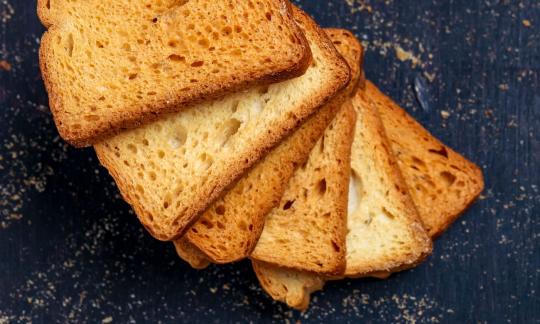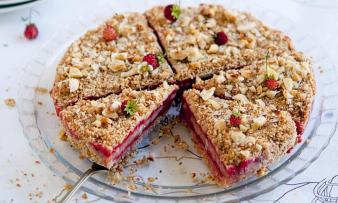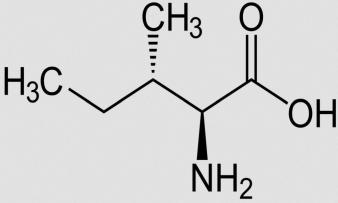Table of contents
Vegan rusks are a popular meal for patients with stomach problems or as a snack for small children because they are easy to digest. The name "Zwie" (two)-"back" (bake) can be traced back to the production process.
Use in the kitchen
Rusk is a dry pastry that is easy to digest. With its slightly sweet taste, it is popular with children and adults. Thanks to the special, double baking process, it is a pastry that can be stored for a particularly long time.
Is rusk always vegan? Often rusks are not vegan, but contain eggs and dairy products (butter, milk powder, condensed milk). Wholemeal and spelt rusks, as well as gluten-free rusks (based on rice, corn, millet and/or buckwheat) often do not contain any animal products. However, these are rarely labeled as "vegan". It is therefore important to read the ingredients list carefully.
Zwieback tastes great on its own or you can refine it with spreads, e.g. pumpkin spread, hummus or pesto. It can be used to make savoury dishes such as Italian bruschetta or Greek dakos. To do this, top the rusks with a mixture of diced tomatoes, garlic, a little olive oil (alternatively: rapeseed oil) and herbs ( basil, parsley). The Greek version also contains black olives and feta (also available vegan). You can also chop up rusks and use them as a croutons substitute in salads and soups.
Many desserts can be made with rusks. Well-known examples are " Poor Knights" and "French Toast", which can be made from rusks instead of toast. For the vegan version, use plant-based milk (e.g. almond milk, soy milk) and an egg substitute (e.g. aquafaba or okara). Combinations such as plant-based milk and corn starch, chickpea flour or rice flour are also possible. Here, use 1 tbsp of starch or flour for every 50 ml of plant-based milk. Alternatively, you can mix a mashed banana into the plant-based milk. Rusks also go well in fruit casseroles, or you can use them to make a strawberry tart or chocolate cake. You can also use it as a substitute for breadcrumbs or ladyfingers (for vegan tiramisu).
Making your own
rusks You can make your own rusks from a baking sheet. You can use yeast dough made from wheat or spelt flour, among other things. After baking the bread, cut it into thin slices and toast them in the oven at a low heat. This darkens the bread and dries it out, creating the rusks we know. The advantage of home-baked rusks is that you can choose the ingredients yourself. If necessary, you can refine the rusks with nuts, dried fruit or spices. You should avoid roasting too much, as this can create undesirable substances ( Maillard reaction). More on this below under Dangers - Intolerances - Side effects.
Vegan recipe for spelt rusks
Ingredients (for approx. 500 g rusks): 400 g wholemeal spelt flour, 100 g light spelt flour, 1 pinch of salt, 250 ml plant-based milk (e.g. almond milk), half a cube of fresh baking yeast (or 1 packetof dry yeast), 80 g vegetable margarine.
Preparation: Mix flour and salt. Heat the plant-based milk slightly and dissolve the yeast in it. Mix all ingredients in a large bowl and knead with a food processor for about 10 minutes. Take the yeast dough out of the bowl briefly, dust lightly with flour and put it back in the bowl. Cover it with a kitchen towel and leave to rise in a warm place for about 2 hours.
Take the dough out of the bowl and knead it again. Then put it in a greased loaf pan. Bake the bread for 50 minutes at 170 °C with convection. After baking, remove the bread, let it cool and cut it into slices about one centimeter thick. Put the bread slices on a baking tray lined with baking paper and dry at 100 °C for around 40 to 45 minutes. At the end of the baking time, the rusks should be slightly brown.
Vegan recipes with rusks (vegan) can be found under the note: " Recipes that have the most of this ingredient ".
| Not only vegans or vegetarians should read this: Vegans often eat unhealthily. Avoidable nutritional errors. |
Purchasing - Storage
Zwieback can be found in the range of large retailers such as Coop, Migros, Denner, Volg, Spar, Aldi, Lidl, Rewe, Edeka, Hofer and Billa, some of which are also organic. Health food stores and organic supermarkets such as Denn's Biomarkt and Alnatura also stock Zwieback.
There are different types of rusks with different compositions. Some (industrially produced) rusks contain milk powder, milk, butter, eggs, salt and sugar, as well as flavour enhancers and emulsifiers. Nutritional rusks have a particularly high butter, eggs and milk content.
In addition to the "classic" wheat rusk, there is also an increasing number of wholemeal rusks, spelt rusks, gluten-free rusks, unsweetened rusks, lactose-free rusks and vegan rusks. Also available is rusk with sugar icing and coconut flakes ( Bergischer rusk) or chocolate coating.
You can also find varieties advertised as "baby rusks". Unfortunately, some of these contain a lot of sugar and other additives. It is therefore important to read the list of ingredients and nutritional values carefully.
The availability of rusks varies depending on the size of the store, catchment area, etc. Our recorded food prices for the DA-CH countries can be found above under the ingredient image - and by clicking on them you can see their development at different suppliers.
Storage tips
Can rusks go bad? They generally have a very long shelf life, but are susceptible to absorbing moisture and thus spoiling. After opening, it is best to store them in a tightly sealed container, which protects them from light and moisture.
Ingredients - Nutritional values - Calories
100 g vegan rusk (organic) has an energy content of 381 kcal. It consists mainly of carbohydrates (78 g), has 5.2 g of fiber and 9.9 g of protein. The salt content is quite high at 668 mg, as is the sodium content (263 mg/100g). This corresponds to about 30% of the recommended daily dose. The fat content is moderate at 4.3 g per 100 g (6.1% of the daily requirement), but consists mainly of saturated fatty acids. 1
All essential amino acids are contained in vegan rusks. Isoleucine (0.49 g) and tryptophan (0.10 g) are present in large quantities per 100 g. The threonine content is also relatively high (0.32 g). Lupine flour, lupine meal and peeled and unpeeled hemp seeds, as well aspumpkin seeds, are particularly rich in protein. 1
Rusks contain hardly any vitamins and only a few minerals and trace elements. Manganese is contained in 0.80 mg/100g. This corresponds to 40% of the daily requirement. Couscous (0.78 mg) and wheat flour (0.79 mg) have a similar content. Foods that are particularly rich in manganese are wheat germ (13 mg) and wheat bran (12 mg). 1
Phosphorus, iron and potassium are also found in smaller quantities. 1
The complete ingredients of Zwieback (vegan), the coverage of the daily requirement and comparison values with other ingredients can be found in our nutrient tables. In the article Nutrients explained you will get a detailed insight into the topic.
Effects on health
Is rusk healthy? Grain products are not exclusively healthy. Grain contains antinutrients (eg gluten and lectins) that can promote inflammation in the body. If these occur frequently, they can trigger various diseases, such as cardiovascular disease, cancer and autoimmune diseases. 4 In addition, rusk is a ready-made product that, depending on the manufacturer, contains large amounts of sugar and salt, as well as preservatives and flavor enhancers, which is not good for your health.
Rusk is a popular snack for young children during weaning from breast milk (supplementary feeding) and beyond. It can also be easily made into puree by adding warm water, which can be supplemented with fruit or vegetables. A Chinese study investigated whether the consumption of fortified rusks could reduce iron deficiency and anemia in young children (6 to 13 months) and came to a positive result. However, this was a rusk specially produced for the study. The results cannot therefore be transferred to "normal" rusks. 3
Is it possible to lose weight with rusks? Rusks have 381 kcal per 100 g. 1 The majority of the calories come from carbohydrates. A piece of rusk (approx. 10 g) contains 38 kcal. Vegetables and fruit are healthier alternatives that help you lose weight. A large carrot has about the same number of calories (100 g = 41 kcal) but keeps you full for longer than a single rusk. You can find more information on the topic of weight loss in our article " Lose weight healthily and permanently ".
Dangers - Intolerances - Side effects
Conventional rusks contain lactose and gluten and are therefore not suitable for people with lactose intolerance or celiac disease. For allergy sufferers, it is therefore important to look closely at the list of ingredients. You can also sometimes find lactose-free rusks and gluten-free rusks that are labelled as such.
Rusks contain sugar and protein (from dairy products). During baking, the amino acids (components of proteins) react with the sugar, which leads to browning and the formation of new compounds (so-called melanoidins). This non-enzymatic browning reaction is called the Maillard reaction. The new compounds are partly responsible for the taste. However, several potentially mutagenic and carcinogenic compounds can also be formed, such as acrylamide. 5
The intake of acrylamide should be as low as possible to protect health. This can be minimized by using less sugar and lower temperatures during production. A test of Austrian foodstuffs (2007-2015) showed a content of 250 µg/1kg for rusks. In comparison, bread contained 46 µg/1kg and potato chips 844 µg/1kg. 6
Folk medicine - natural healing
Rusk is easy to digest for most people. In the case of illnesses such as gastrointestinal complaints, diarrhea, vomiting, nausea or loss of appetite, rusks are recommended as a light meal. It is a "traditional home remedy" whose effectiveness has not been proven by studies.
Ecological footprint - animal welfare
Despite extensive research, we were unable to find any precise figures on the ecological footprint of vegan rusks. The figures depend on the individual production processes, starting with the ingredients used, the subsequent processing and finally the packaging.
In 2019, the Institute for Energy and Environmental Research Heidelberg ( IFEU) examined almost 200 foods in Germany for their environmental impact. The calculation of the CO 2 footprint is based on average values for agricultural production (including all upstream processes, such as fertilizer production), food processing, packaging (including disposal of the same) and distribution to the supermarket. Fine baked goods (which include rusks) require 1.6 kg CO 2 eq/kg. 9
Wheat bread has a global average water footprint of 1608 l/kg, and cherries use a similar amount of water. Average vegetables, however, only need a fraction of this amount of water (322 l/kg). Potatoes, for example, which are also carbohydrate-rich foods, have a water footprint of just 287 l/kg. 10
For detailed explanations of various sustainability indicators (such as ecological footprint, CO2 footprint, water footprint), see our article: What does the ecological footprint mean?
Animal welfare - species protection
Agriculture is one of the most important factors in the rapidly increasing loss of species. After soy, wheat is the crop with the largest biodiversity footprint. This is partly due to the fact that wheat cultivation requires a lot of land. 11 Added to this is the use of pesticides and mineral fertilizers, which not only has drastic consequences for fauna and flora, but also for us humans. 12
Worldwide occurrence - cultivation
The origin of rusks is not known for certain. In ancient times, people knew of twice-baked bread. Because of its long shelf life, rusks were used as supplies on sea voyages or as food in the military during wartime. It was only later that its composition was refined and rusks found their way into everyday diets.
Particularly nutritious rusks were sometimes sold, so-called nutritional rusks. These contain 10 kg of butter and 10 kg of whole eggs or the corresponding amount of egg yolk and whole milk or milk powder that corresponds to the whole milk mass per 100 kg of grain flour. 2
Industrial production
To make rusks, you first bake a sweet, white bread-like pastry made from yeast dough, known as einback. Yeast dough often contains finely ground wheat flour, but spelt or wholemeal wheat flour is used less frequently. Traditionally, butter, milk, eggs, sugar and salt are added to the flour and yeast. Industrially produced rusks, on the other hand, contain condensed milk, whole egg powder, vegetable oil (sunflower oil), flavour enhancers and emulsifiers (soy lecithin). After baking, a machine cuts the einback into thin slices, which are then roasted in the oven at a low heat. A baking tunnel is usually used for the second baking process. The slices turn dark, dry out and are now crispy. 7 The rusks, the twice-baked pastry, must be dried in a drying chamber and then cooled until they have a water content of less than 1 to 1.2%. The rusks are then packaged for sale. 8
Further information
Zwieback should not be confused with Tweeback, also called Mennonite Zweiback, which is a soft yeast pastry in a double ball shape.
Rusk-like pastries can be found all over the world. They originally came from preserving bread. Nowadays they are used as a snack or pastry. Since they can be quite hard, they are dipped in soups, coffee, tea, juice or milk drinks.
Alternative names
In English it is also called zwieback or rusk, cracker, toast or twice-backed bread.
Bibliography - 12 Sources (Link to the evidence)
| 1. | ÖNWT Österreichische Nährwerttabelle. Zwieback eifrei (BLS3.02 D038000). |
| 2. | Bundesministerium für Ernährung und Landwirschaft. Deutsche Lebensmittelbuch-Kommission. Leitsätze für Feine Backwaren. Letzte Änderung 2010 (PDF). |
| 3. | Liu DS, Bates CJ, Yin TA, Wang XB, Lu CQ. Nutritional efficacy of a fortified weaning rusk in a rural area near Beijing. Am J Clin Nutr. 1993;57(4):506-511. |
| 4. | De Punder K, Pruimboom L. The dietary intake of wheat and other cereal grains and their role in inflammation. Nutrients. 2013;5(3):771–787. |
| 5. | ALjahdali N, Carbonero F. Impact of Maillard reaction products on nutrition and health: Current knowledge and need to understand their fate in the human digestive system. Crit Rev Food Sci Nutr. 2019;59(3):474-487. |
| 6. | AGES Österreichische Agentur für Gesundheit und ERnährungssicherheit GmbH. Rückstände und Kontaminanten von A bis Z. Acrylamid. |
| 7. | Schünemann C, Treu G: Technologie der Backwarenherstellung. Fachkundliches Lehrbuch für Bäcker und Bäckerinnen. 10. Auflage. Alfeld (Leine): Gildebuchverlag; 2009. |
| 8. | National Institut of Food Technology Entrepreneurship and Management. Ministry of Food Processing Industries. Gouverment of India. Reading Manual for Rusk under PMFME Scheme. |
| 9. | Reinhardt G, Gärtner S, Wagner T. Ökologische Fussabdrücke von Lebensmitteln und Gerichten in Deutschland. IFEU Institut für Energie- und Umweltforschung Heidelberg. 2020. |
| 10. | Mekonnen MM, Hoekstra AY. The green, blue and grey water footprint of crops and derived crop products. Hydrol Earth Syst Sci. 2011;15(5):1577–1600. |
| 11. | WWF Deutschland. So schmeckt die Zukunft: Der kulinarische Kompass für eine gesunde Erde: Ernährung und biologische Vielfalt (Zusammenfassung). 2022. |
| 12. | Zaller J. Unser tägliches Gift: Pestizide die unterschätzte Gefahr. 1. Auflage. Wien: Deuticke im Paul Zsolnay; 2018:116-130;146. |









Comments